Features overclocking
I recall that in the first part of the review we examined the performance of the fastest desktop processor in the nominal mode. The increase in size of the two cores, slightly faster architecture, as well as the frequency margin allowed Core i7-6950X ahead of the former flagship 8 — core Core i7-5960X in multi-threaded applications on average by 30-35%. This is an extensive progress. And yet the performance of the chips Broadwell-E actually increase with acceleration, the benefit of all 14-nanometer processors got an unlocked multiplier. Platform because extreme.
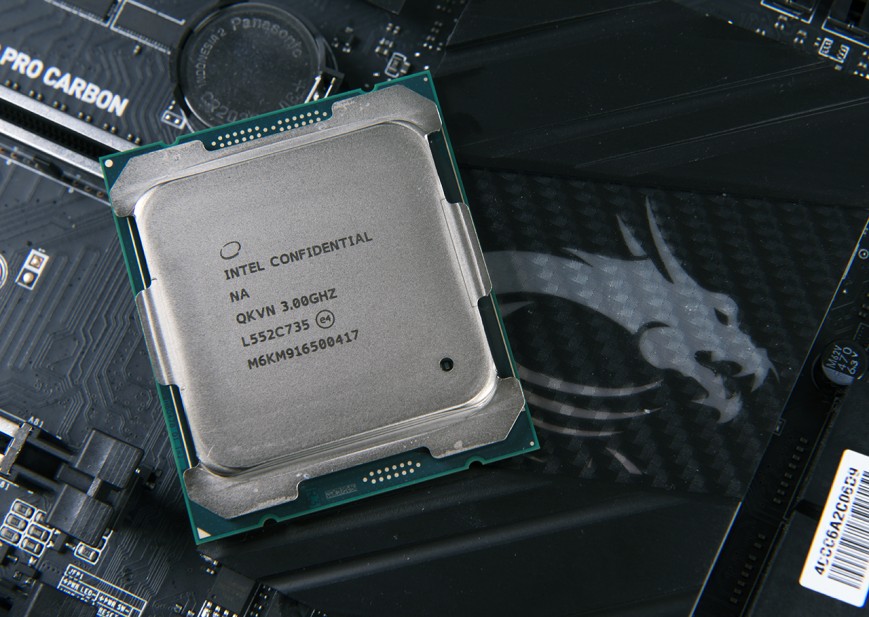
Review Intel Core i7-6950X. Part 2: acceleration 10-core processor
In the first part I have described the principle of operation of Turbo Boost Technology 3.0 Max. Useful technology, because not all applications require ten cores. Sometimes just one or two, but very fast. In such cases the driver (sorry,Turbo Boost Technology 3.0 Max does not work without the software automatically accelerates one core up to 4 GHz. In General, as we have seen, in complex multi-threaded tasks, the Core i7-6950X operates at a frequency of 3.4 GHz for all ten “heads”, if you can withstand the cooling system, of course. Full list of characteristics is given in the table below.
Intel Core i7-6950X
Process technology
14 nm
Architecture
Broadwell
Socket chipset
LGA2011-v3, X99 Express
The number of cores/threads
10/20
Clock frequency (Turbo Boost)
3,0 (3,5) GHz
Cache in the third level
25 MB
Controller PCI Express 3.0
x40
The memory controller
DDR4-2400, 4-channel, up to 128 GB
TDP
140 W
Price
$1723
Buy
Call vertelki:Intel Core i7-6950X5901203inline
The second interesting innovation is the detailed setting each core individually. Nothing special in the process of setting up Core i7-6950X no, but the implementation of this function makes the platform LGA2011-v3 is more flexible in terms of overclocking. Coupled with Turbo Boost Technology 3.0 Max, where you do not need the power of ten cores to choose really high multipliers, for example, chips Skylake for mainstream LGA1151 platform. Let me remind you that Core i7-6700K in default operates at a frequency of 4 GHz.
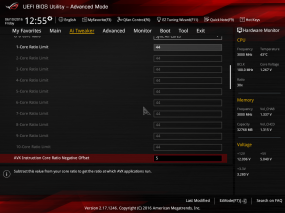
BIOS motherboard ASUS
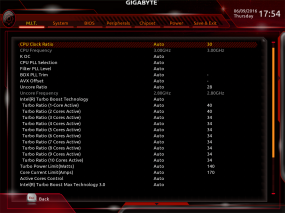
BIOS motherboard GIGABYTE
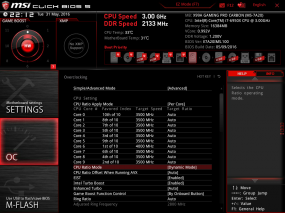
BIOS motherboard MSI
The second important innovation is the management of the multiplier cores in the moments when the software uses AVX instructions. ASUS this function has been called AVX Instructions Core Ratio Negative Offset, GIGABYTE — AVX Offset, MSI — CPU Ratio Offset When Running AVX. It is known that vector instructions heaviest load on the CPU. Core i7-6950X — 10-core, but because in most cases the main reason for the bad acceleration it will be the lack of efficiency of the cooling system. Option to reduce the multiplier when used AVX instructions, solves this problem. Moreover, we consider that in most household tasks, including games, vector set of teams is almost never used.
The name of the option in Machpelah different, but the principle is the same everywhere: we specify a negative coefficient — the multiplier by which the frequency will be reduced when used AVX instructions. For example, if all ten cores working on the scheme 100х45=4500, and offset indicator is equal to five, when you start, for example, LinX versions 0.6.5 and above owning the vector command, the speed of the chip automatically drops to 100х40=4000 MHz.
And again, we are dealing with a great customization of the workflow Broadwell-E. by the Way, something similar happens if you overclock powerbrokers chips for LGA1151 platform. Albeit reluctantly, but Intel has allowed manufacturers of matplot to release their BIOS, razblokirovanie the frequency of the clock generator. The speed of the chips Skylake actually increase, but instead the processors of major “cut” the performance of the AVX commands that for games — critical.
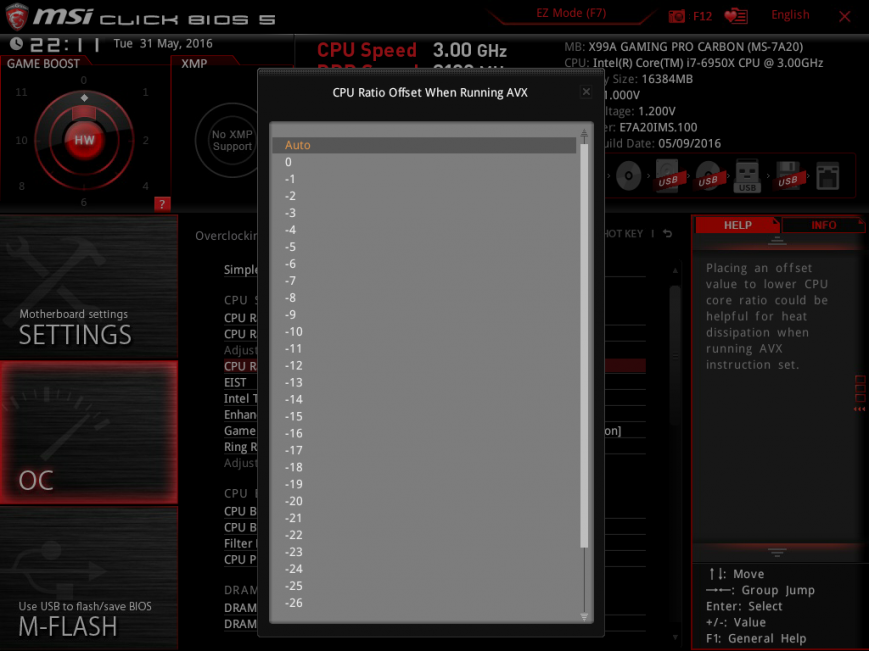
Setting the multiplier for AVX-teams
New processors received a larger number of divisors of RAM. For example, to disperse the “brains” to the effective frequency 3000 MHz with a processor Haswell-E will need to set the parameter DDR4-2400, and the speed of the clock generator to increase up to 125 MHz. The memory controller chips Broadwell-E has the most divisors. Supports modules with the effective frequency up to 3800 MHz.
The test stand was used 4 channel kit Corsair VENGEANCE CMK32GX4M4B3000C15. He works on the effective frequency 3000 MHz with timings 15-17-17-35 at a voltage of 1.35 V. the Total amount of 32 GB.
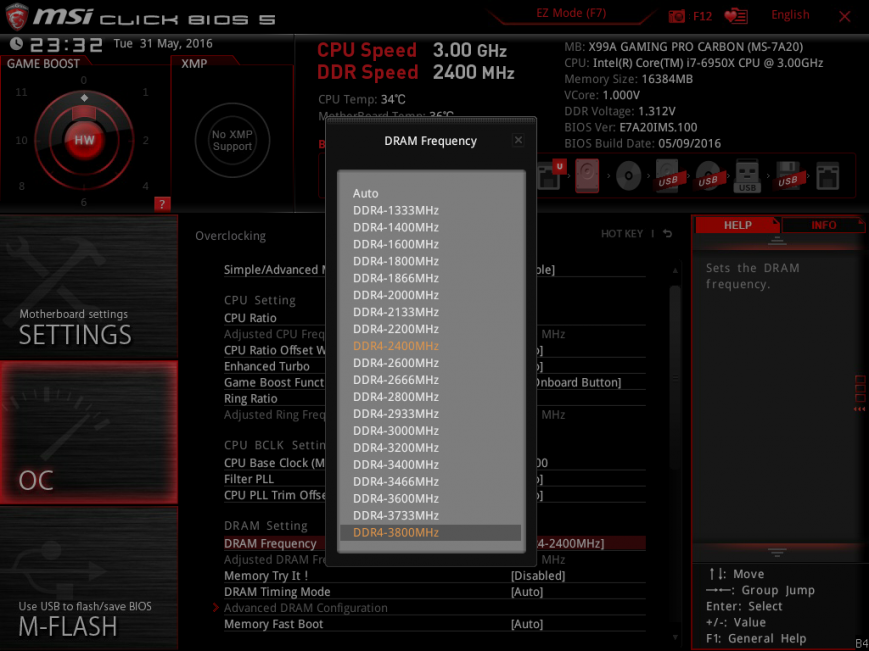
Dividers memory for Intel Broadwell-E
Finally, the opportunity to regulate the voltage VccU. With its help overclocking more accurately controls the frequency of the cache memory. As you can see, a lot of innovations. Their objective is to make the processors Broadwell-E is more efficient and faster in all task types. Will try to squeeze out 10-core Core i7-6950X a few more.
Results
Test stand:
- CPU: Intel Core i7-6950X, 3 GHz
- Cooling: Corsair H110i GT
- Motherboard: MSI X99A GAMING PRO CARBON
- Video card: NVIDIA GeForce GTX 980 Ti 6 GB
- RAM: DDR4-2400 (15-15-15-36), 4x 4GB
- Storage: SSD Patriot Blast, 480 GB
- Power supply: Corsair HX850i, 850W
- Operating system: Windows 10 x64
Immediately should tell you about the cooling. Obviously, along with Core i7-6950X you must use either the so-called supercooler (comparative test of popular models), or maintenance-free liquid cooling system. My choice fell on “dropsy” H110i GT from Corsair (overview). This is the flagship model with a two-piece radiator and 140 mm fans.
Already in the nominal Core i7-6950X makes serious demands on cooling. If you do not use AVX commands (LinX 0.6.4), then the H110i GT holding temperature of the hot nuclei in the range of 50 degrees Celsius. If you use a vector instruction, then the load on the “dropsy” significantly increased already at 10 degrees Celsius. Please note that in the default state Core i7-6950X works with relatively low voltage of 1 V. In this case, as I said, under load LinX 0.6.5 all cores worked at a frequency of 3.4 GHz.
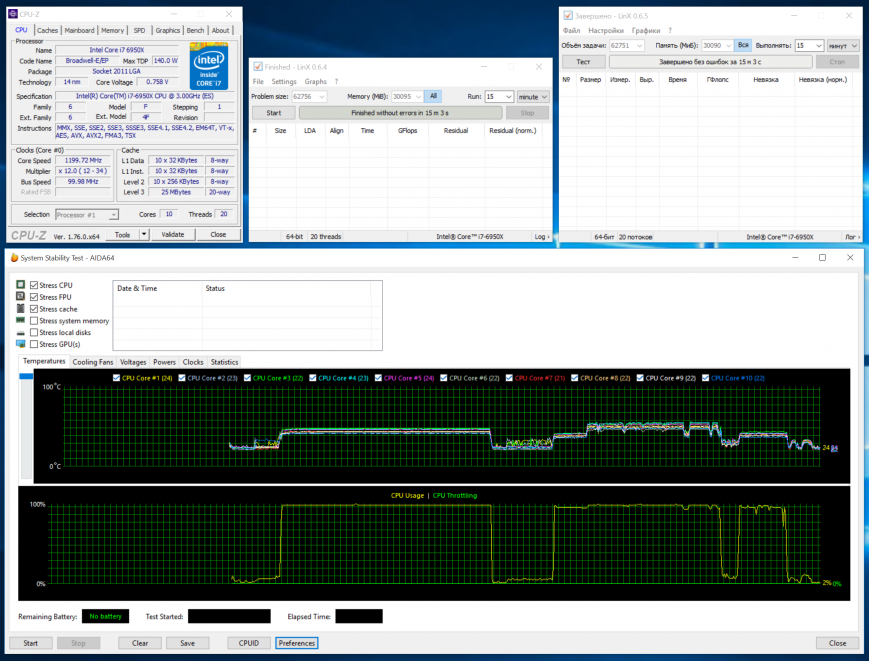
Cooling Intel Core i7-6950X. The value
The crackdown was carried out in two stages. The first is the easiest. I increased the multiplier from default 30 to 40 units, and the voltage to 1.25 V. finally got stable in LinX 0.6.5. Without throttling, although the temperature of the hot nuclei close to the peak 100 degrees Celsius. Any subsequent increase in the frequency led to overheating. And it’s H110i GT!
The second method was to search for the optimal balance frequency with which the Core i7-6950X will work in software, not using vector instructions. She was — 4.3 GHz for all cores. For this I have increased the VCore voltage to 1,275 V. Stress testing in LinX 0.6.4 system took place, but in LinX 0.6.5 constantly bothered blue screen of death. Had to use the AVX feature Offset and reduce the multiplier for these kinds of tasks from five points. As you can see, in the beginning appeared trottling in the amount of two percent, but the overall system kept stable for AVX 3.8 GHz and 4.3 GHz for everything else. Even with the H110i GT allowable temperature kept, as they say, thin. Without AVX decategory processor at a frequency of 4.3 GHz in LinX 0.6.4 just warmed up to 80 degrees Celsius. The difference is huge.
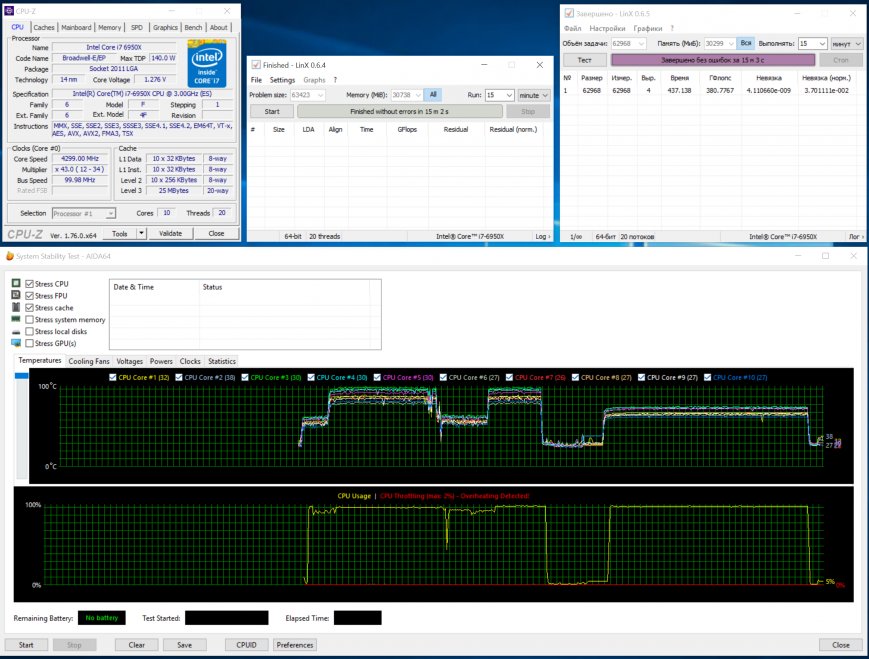
Cooling Intel Core i7-6950X. Acceleration
10 cores while overclocking is not a joke. The increase in “naprugi” and frequency has significantly increased the system power consumption. Why be surprised that H110i GT barely copes with cooling overclocknet Core i7-6950X, is not necessary.
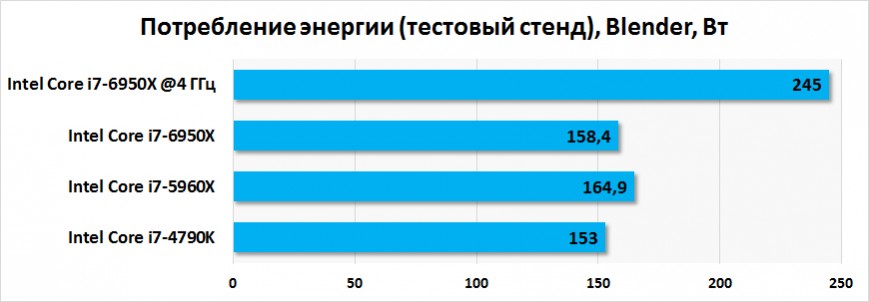
The energy consumption of the Intel Core i7-6950X
So which is overclocking better? CINEBENCH and 3Ds Max have reported that the variant with unequal acceleration (total — 4.3 GHz; AVX — 3.8 GHz) is preferable. The software does not use AVX, so there is nothing surprising.
Note that overclock gives a significant performance boost. In the same CINEBENCH ten cores, up to 4.3 GHz overclocknet, “bring” denomination of as much as 23.4 per cent.

The results of testing Intel Core i7-6950X in CINEBENCH R15
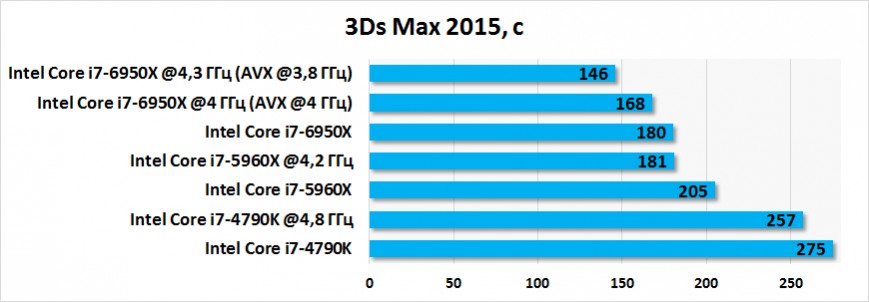
The results of testing Intel Core i7-6950X in 3Ds Max 2015
A similar situation is observed in games, but in GTA V, Far Cry 4 and Metro: Last Light is the difference between 4GHz and 4.3 GHz is negligible. The potential of the GeForce GTX 980 Ti in Full HD is almost exposed. However, the graph clearly shows the situation that this video card is sufficient and fast Quad-core Core i7-4790K.
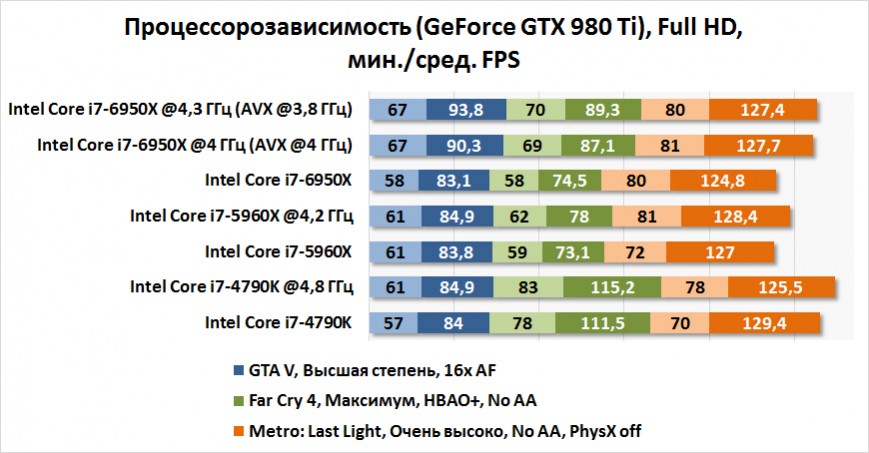
The results of testing Intel Core i7-6950X in games
LuxMark, x265 Bench and Blender — here is a good examples of where the much faster AVX is preferable. On the other hand, the difference between 3.8 GHz and 4GHz is irrelevant. But it’s there.
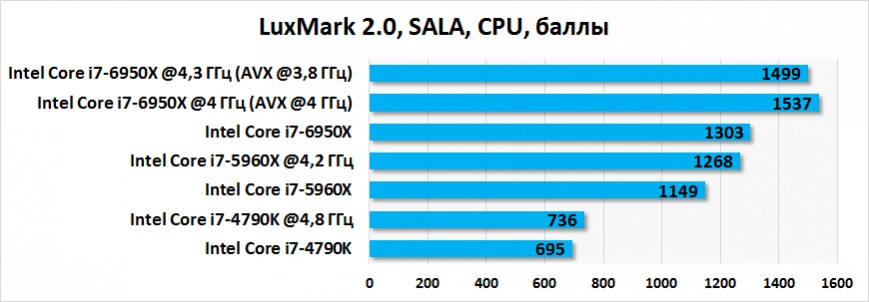
The results of testing Intel Core i7-6950X in LuxMark
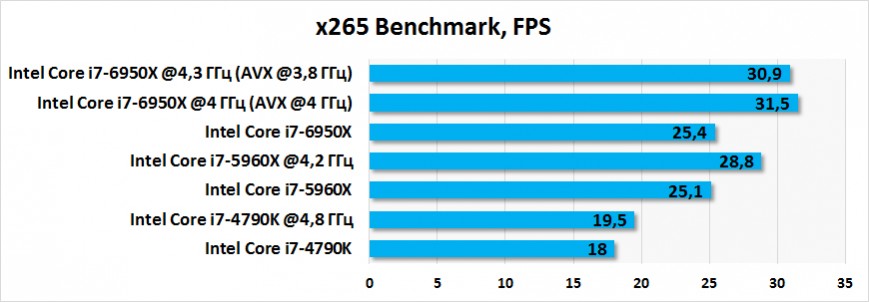
The results of testing Intel Core i7-6950X in x265 Benchmark
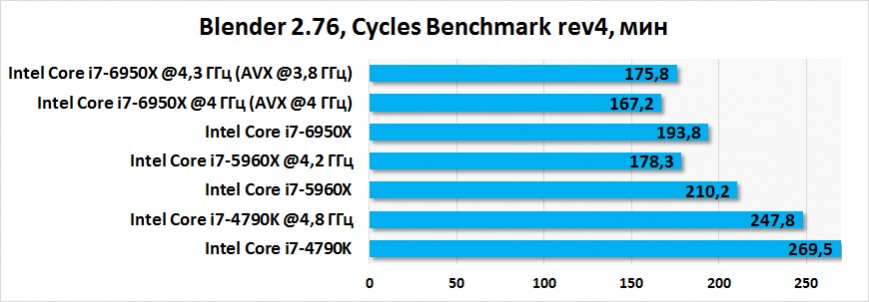
The results of testing Intel Core i7-6950X in Blender
In conclusion
Testing has shown that cooling the overclocked 10-core — not an easy task. With her struggling to cope even top “dropsy”, if to speak about devices that don’t need to collect yourself. And yet flexible configuration allows, so to speak, to “get out” of the situation. The recipe is simple: there is no need for AVX-instructions — do not use them. This pattern works fine if you plan to do the chip Broadwell-E platform LGA2011-v3 is the basis for a gaming build.
To overclock Core i7-6950X definitely makes sense. Increasing the frequency gives 20-25% increase in multithreaded applications.
The fact that the Central processor is extremely slow progress in terms of performance, discussion has long been not subject. Intel all the harder given the development of new technological processes. Not just long-standing strategy of “tick-tock” in 2016, was changed to “tik-tak-tak”. Therefore, an extensive way of development — most likely today. In this scenario, functions that point to control the CPU and to configure it for a particular type of task come to the fore.
